TL;DR
Traditional training is slow, static, and forgettable. Just-in-time learning delivers the right coaching, content, and context in the flow of work so people can execute now. With Spekit, that looks like AI Sidekick for proactive answers, collaborative Deal Rooms to educate buyers, Playlists for dynamic everboarding, and Revenue Insights to prove impact on pipeline. The result is faster ramp, consistent execution, and measurable revenue outcomes.
Introduction
Whether you’re starting a new job or years into your career, there is one constant in the workplace: you never stop learning. Training and development are the foundations on which a business can stay competitive, relevant, and supportive of its employees. But training takes time and money, isn’t always personalized to different types of learners, and often gets forgotten long before it’s put into practice. While there’s always a place for traditional learning, just-in-time learning helps employees become exponentially better every day with contextual, bite-size knowledge, delivered where and when they need it.
In this guide, you’ll learn everything you need to know about just-in-time learning and how some learning and development leaders from organizations like Slack and Snowflake use it as a key tool in their toolboxes. The benefits — from boosting productivity, encouraging self-sufficiency, and cutting ramp time — all directly translate to changes that help companies keep up with the current pace of business and achieve better outcomes.
If you’re ready to make the move from employees who learn to teams that are knowledgeable, read on.
Everything you need to know about just-in-time learning
The way we work today is constantly evolving. And in the last few years, we’ve seen more change than anyone could have predicted. Not only are many desk workers now tuning in from their home offices, changing the way training is even delivered, but budgets are up in the air, so enabling productivity without burning people out is a necessity.
When Melanie Fellay co-founded the just-in-time learning platform Spekit, she did so because she knew just-in-time learning was built for how we work today — not the “today” of two years ago. “Just-in-time learning is a more agile approach to learning, making it easier to drive change when and where people need it,” says Melanie.
“It’s a new way of training your team to be successful that’s all about meeting your employees where they are. I really just pictured a more instant way of helping people find information when they need it in the moment.”
Where traditional training is occasional, out of the context of workflow, made for a general audience, and often lengthy and formal, just-in-time learning is consistent, bite-sized, personalized, presented in the flow of work when and where it’s needed, and reinforced.
Imagine asking a middle school student today to write a report using only an encyclopedia simply because that’s how the teacher has always done it. That concept mirrors some of the current challenges we see with learning at work. “The world is really approaching training the same way that we were 10 years ago,” says Melanie. “Pre-pandemic and the move to remote, pre-Cloud and SaaS proliferation, pre-recession — but the world has changed.”
Experts studying the science of learning know the way we were taught to learn is out of date. According to the National Education Association, these researchers suggest a few key changes:
- Cramming is out, distributive (or spaced) learning over time is in
- Interleaving, or bouncing your focus between topics, helps with linking concepts and processes together
- Connecting learning to real life makes it more memorable
- Combining text with visuals like videos or graphs makes learning more concrete
Leaning on less modern methods looks like:
Content that’s out of date
The pace of business today doesn’t slow for anyone, which means the content of your training can be irrelevant before it’s even been widely circulated. Like that student writing the report, the facts found in a text that can’t be updated will never tell the full story, and neither will learning materials that don’t evolve as new information becomes available. This means not only is the information outdated but the work of your valuable training and enablement teams isn’t being put to best use.
Difficulty finding the right information right when you need it
Imagine you’re in the zone, working in Salesforce, inputting data and cleaning up opportunities. Suddenly, you can’t remember the criteria for converting an opportunity from Stage 1 to Stage 2. To get that answer, you’re forced to leave your flow state and dig through a lengthy document, review an old training session or ping a colleague.
When you’re in the flow of work and need a piece of information to continue, nothing breaks down efficiency like having to context-switch into various different tools to try to find what you need. When information is hard to find — especially when it only exists in the brain of another coworker — that’s when bottlenecks happen, and bottlenecks aren’t compatible with today’s pace of business. “The main thing is that information is accessible when and where you need it,” says Melanie, “whether that's embedded or a click away.”
The cost of context-switching
Context-switching happens when you jump between tasks, tools, or projects, and it’s a time thief. People take almost 10 minutes to get back into a flow when context-switching between apps. A recent study of 20 teams across three Fortune 500 companies found "that workers toggled roughly 1,200 times each day." That adds up to four hours each week or four weeks in a year spent simply reorienting yourself.
A lack of reinforcement
Processing information is not and has never been “one-and-done.” True understanding requires ongoing reinforcement that meets the user where they are. “There's a limit to how much information you can take on at once,” says Melanie. “In order to remember something it needs reinforcement, so if you're just communicating something once in an email or a webinar, people are not retaining that information.” This could be an even greater disadvantage for remote workers who no longer have access to the in-person knowledge absorption that happens on the job.
Part of why learning at work has been slower to catch up as most other business areas have taken off, is because learning hasn’t always had a seat at the table. In today’s job market, where budgets are tight, and staff numbers are diminishing, companies must maximize their investment by helping employees learn and become more effective and productive.
“I think for a long time, training was really seen more as an HR function,” says Melanie. “But in the last few years, training and operations teams really rose to have a much more important role — we started to see them as a way to multiply efforts and see more results.”
So how does just-in-time learning affect all of the above?
Reduces the friction of learning to make it a habit, not a chore
We’ve established that learning at work is a constant, so why not make it part of an employee’s daily routine rather than an occasional interruption? “If you need something in the moment, like when you're just trying to get something done, it's all about how quickly we can reduce that friction,” says Melanie. The easier a tool can make a process consistent, the more likely that process will be used.
Empowers employees and enables self-sufficiency
Nothing feels better or more empowering than being able to solve your own problem, especially when you’re learning something new. Building up confidence in employees is just as important as ensuring they’re doing their jobs right, so having tools that breed self-sufficiency can also work towards your retention goals. “Especially when you’re new, you don’t want to be bugging your coworkers or your manager,” says Melanie. “When you don't know where to find something, it can really hurt your confidence.”
Keeps employees in the flow of work and helps boost productivity
It’s normal to switch between tools during a workday, but when you have to stop what you’re doing to go and find an answer—or you can’t even continue because you don’t have an answer—that’s when productivity ends.
“That’s why we believe in a more self-serve ‘pull approach,’ when you need it, it's going to be there, and you're not going to have to look for it,” says Melanie.
Keep reading to learn four truths about the modern, fast-paced workplace and how just-in-time learning can help you meet shifting business objectives and create a more supportive working environment, all while ensuring employees don’t just learn but become knowledgeable.
“I think this paradigm shift needs to happen,” says Melanie. “Are you trying to track whether someone is checking a training box, or do you want to make sure people have the knowledge, understand it, and truly retain it?”
That’s where just-in-time learning comes in.
The pace of business has changed — learning must keep up
The business world has shifted in so many ways in the last few years — hybrid and work-from-home accommodations, a recession, and the globalization of the workforce. But the acceleration of digital technology might be the biggest catalyst for enhancing the pace of business, resulting in a constant need for more knowledge.
Deals are moving faster, budgets are getting smaller, there are fewer funding dollars available, and time to market keeps speeding up. Because of this converging of elements, employees are required to juggle more than ever:
The number of SaaS tools is up: Ask any current office worker about the explosion of tools they’ve experienced recently and all the training and time they each require.
The number of competitors is up: The industry is saturated, and truly knowing your competitor is not the simple task it once was.
The number of products and services is up: Companies are offering more now to keep pace and stand out, which means more knowledge for their teams to absorb.
The number of delivery methods is up: For an average worker juggling multiple tools, there are so many places where information might be housed. Jumping between email, Slack, Google Docs, an LMS—sometimes it’s hard to know where to even begin searching.
It’s exhausting just to think about! And without a doubt, businesses will continue to be impacted by this rapidly changing technological landscape. Much of how you insulate yourself from the effects comes down to choosing the right tools and processes for your organization. In short, for a business to keep up, the way its employees learn must keep up, too.
According to Forbes, “to prepare for [this accelerated digital transformation], businesses must ensure they embed the right technology throughout their process and in every area of operations.”
Getting proactive in a reactive world
When the pace of business picks up, it’s natural to feel like you’re always reacting, but even if it feels relevant at the time, reactivity is never a long-term solution.
“When you’re in reactive mode, just taking requests and creating programs based on those requests, you’re always playing catch up,” says Nick Lawrence, Curriculum Design Manager for Learning Experience at software development company Snowflake.
“There’s no longevity to the program. You’re not sustaining the behaviors you need to sustain.”
Because formal learning and training are so resource-intensive, it takes time, energy, and expertise to create. When the market moves as fast as it does, those traditional types of programs suddenly lack longevity. What help is a webinar about how to use a tool that’s already being replaced by something better?
According to Nick, being proactive relies on the following:
- Understanding which outcomes you’re trying to drive
- Creating clarity around competencies
- Intentionally providing resources to support the execution of those identified behaviors
You don’t need to change your strategy every time the business world takes a left turn if your strategy is based on outcomes and behaviors. Given the right tools, employees can feel a stable, consistent level of preparedness rather than getting seasick from all the flip-flopping.
Meet employees where they are
One way to grow and drive revenue without spending as much is by ensuring that your employees are happy and knowledgeable. As important as creating a stable environment for your employees to learn is making sure it’s the right environment — one that meets them where they are.
“It's a highly competitive environment today, and more people are changing jobs than ever before,” says Kari Roberts, Revenue Operations at integration platform Boomi.
“People are expecting more from companies.”
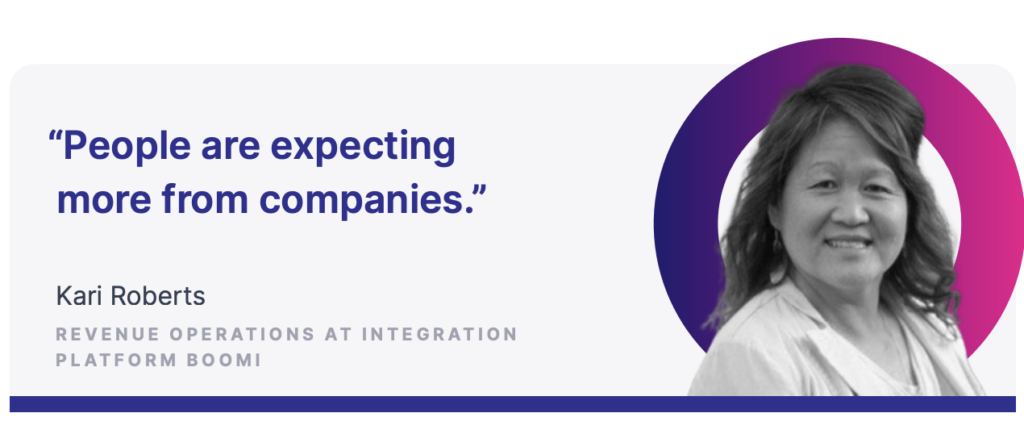
What are folks expecting? “They need the right tools,” says Kari. “They can't do it without tools and technology these days. And they need support.” Supported employees are happy employees, and happy employees are 13% more productive, according to an Oxford University study.
In support of the employees now wearing multiple hats, the organizational process needs to come from the top down; arming your team with the necessary skills and tools means having a plan yourself and the right resources to bring that plan to life. “You have to do more with less these days,” says Sheevaun Thatcher, VP of Global Sales & Success Enablement at Slack, “which means we have to be absolutely prescriptive on what we do; otherwise, the whole team is going to burn out.”
Burnout has always been a problem, but with reduced budgets and rising layoffs, it’s become costlier than ever. Doing more with less has been table stakes for a while now. Without a model like just-in-time learning to help build a small headcount into a productive team, it can feel like walking the tightrope between providing the right training resources and support and not overburdening your employees with too much knowledge that they aren’t able to put into practice right away.
“Be conscious of the amount of information you're trying to get them to consume, and ask yourself if that information is relevant to what they're doing right now,” says Sheevaun.
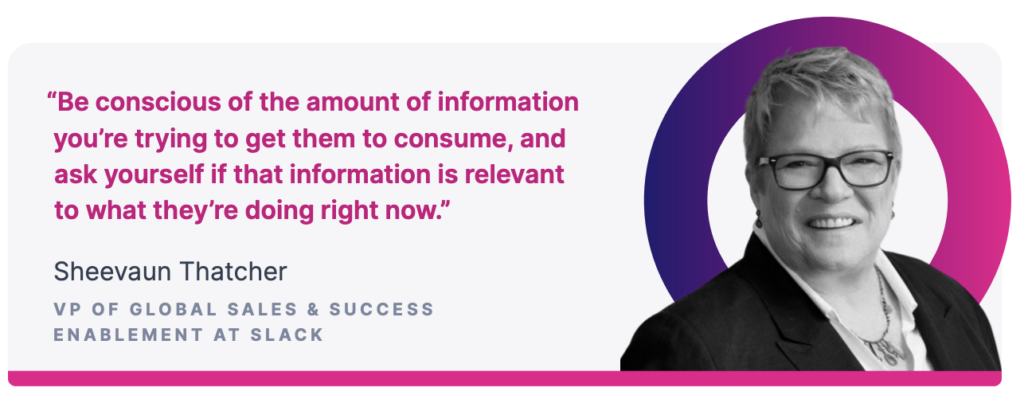
Like dropping new products into the market, providing learning opportunities for your team is all about timing. “If you’re training at the end of the quarter, you’re going to hear ‘do not bother me,’” says Sheevaun. “But if you're providing support at the right time, there can be a lot of excitement around it. Then they take it and embed it in what they're working on.”
"All learning should be measurable in some fashion,” says Sheevaun. “It must support productivity that affects either time, money, or resources. If outcomes aren’t measurable, you should ask yourself if they’re worth the effort.”
The pace of the market dictates so many business decisions that it can feel like you’re no longer steering the ship of your own organization. But business practices will always evolve, and things are only moving faster as we dig deeper into what tech can do across industries.
Enabling remote learning is critical
Training has almost always been a social endeavor — as much an opportunity to build community and create camaraderie as it was to share knowledge. No one was prepared for the mass move to the home office, which meant training and enablement teams were left scrambling for ways to facilitate learning remotely effectively. We saw the same shifts in industries like events and conferences, where what was once a mostly in-person experience got moved online — without a playbook.
About a quarter of the U.S. workforce is expected to work fully remotely by 2025, and over 70% of those surveyed by PwC said they’d prefer a hybrid experience versus working full-time back in the office. The gates have been opened, and they’re not closing anytime soon. And while many teams have learned how to work well together from afar, learning at work is still catching up.
“How do you create engaging experiences? How do you maintain everyone's attention? And how do you create a sustainability plan around whatever it is you're trying to teach?” asks Garrett Rafols, Senior Director, Center of Excellence at Gympass, formerly of LinkedIn. “These are things that I think no one has really perfected.”
The power of personalized, on-demand learning
Every tool we use in the rest of our daily lives is personalized to us and at our fingertips, so why should learning at work be any different? Social media algorithms feed us ads that suit our tastes, and you can teach yourself how to do anything online exactly when you need it. That’s what just-in-time learning understands — that how we learn everything else in life is also how we should learn in the workplace.
“In my free time, I don’t watch videos on how to fix my dishwasher in the event that it breaks. I only watch that video if the dishwasher actually breaks,” explains Nick Lawrence.
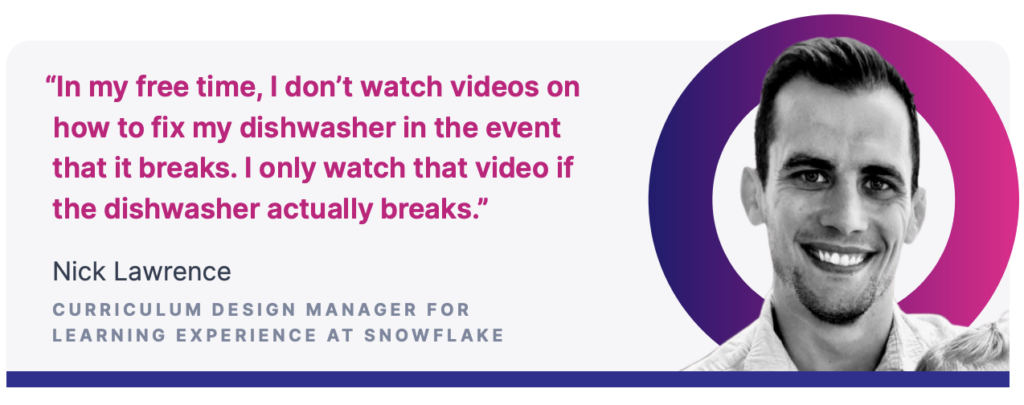
“And that's really important, especially for salespeople — they’re extremely busy, they’re already only spending like a third of their time on revenue-generating activities, and the last thing they want to do is watch an hour-long, e-learning course on something that might apply in the future.”
We’re used to learning like this now: in the moment, in the thick of it, with information that’s accessible and easy to find. We’re not memorizing the manual on day one, especially not as companies offer more products and services than ever before. When teams are remote, this kind of learning is even more valuable.
“I think, initially, when going remote, folks had to figure out how to focus. It's too easy to get up from your chair, wander around the house, and get distracted, so there is a distinct lack of patience,” says Sheevaun Thatcher.
“People are not prioritizing long learning sessions anymore. They're prioritizing just-in-time learning because ‘this is what I'm dealing with right now. This is what I need you to help me solve.’”
Of course, some new information requires a longer format or even a company-wide gathering. What’s important is to consider the format of the information you want people to put into practice from day one. “It's got to be in small, almost instantaneous bites,” says Sheevaun. “And it matters where I get it, when I need it, and in what format. I need it where I am.”
Creating an environment of self-sufficiency
“People are being tasked to do their jobs completely alone,” says Garrett. “It's not as easy as just turning to someone — you have to be a bit more motivated to put in a ticket. So you need to be a lot more independent.”
When managing a remote team, it’s challenging to provide independence without making team members feel isolated. Whether onboarding new hires or updating current employees on new processes, the distance created by remote work takes away the safety net of being able to ask a casual question without feeling like a burden on your team members.
“There’s only so much that a worker can do on their own,” says Garrett. “E-learning providers are fantastic resources, such an incredible asset — but that requires believing that the learner is going to be able to do it on their own.” Not only that employees will be able to complete distance training without help or supervision, but they’ll retain the information over time and will correctly apply the learned skills to their role.
“It still needs to be coached, they still need learning through instruction, they still need guidance, and these are the things that are hardest to do in a remote work environment.”
Experts like Garrett have found that the right tools and platforms can bridge that gap that remote work has widened. “Giving people tools to be more efficient at work has never been more important because we are remote,” he says. “These tools, these systems, these things that make our job easier continue to make us productive.”
That self-sufficiency afforded by the right learning tools does more than provide people with the support they need, delivered in the format they want when they need it, but it also saves time and money up and down the ladder. Employees that exhibit self-sufficiency save manager time, avoid bottleneck situations and waste less on-the-job time seeking answers.
When just-in-time learning is employed in a remote environment, it’s a little like having one manager for every employee, ready when they need them and always with the exact right answer. And that kind of support is a welcome change for those who’ve spent the last few years with less mentorship and support than they might have needed.
Driving productivity and efficiency is essential
Because there is more information than ever to contend with and more tools to learn to process all that information, being able to streamline processes effectively is one of the keys to enabling a productive workplace. If teams are left to seek out their own answers from many disparate sources all day, it’s less likely their work will produce as much value as possible if they had the tools they needed to stay in a flow state.
Poor productivity does more than waste time throughout the day. It also suppresses creative impulses, which often lead to innovation and decreases morale which can result in increased turnover rates that cost organizations agility and profitability.
Sheevaun Thatcher of Slack has four pillars she applies to sales enablement to ensure everyone is working at their full potential:
- Ensuring a common understanding of the go-to-market strategy across the board
- Aligning all the assets — scripts, websites, decks — and verifying there’s only one version of each that everyone’s referring to
- Delivering information via just-in-time learning
- Conducting gap analysis to learn what is and isn’t working
For her, making sure everyone comprehends the plan, is given the correct assets to do their jobs, and delivering that knowledge with the least friction possible has made all the difference to her team’s success.
“You need to make sure that everything you have on the enablement side of the business is available, accessible, and in the modality that is the most useful,” she says.
The obstacle of context-switching
When information isn’t delivered in the place or context that would make it the most valuable to the employee, that means they must seek it themselves. Because of the proliferation of tools now in use, even zooming out on your screen to begin a search opens up Pandora’s box of possible distractions.
Psychologist and computer scientist Gerald Weinberg found in his research that productivity is killed by up to 80% when you’re attempting various tasks at once. His study shows that once a person’s focus is split, even just between two different contexts, 20% of your productivity evaporates altogether, with the other 80% split between your tasks.
When doing deep work, like learning something new or programming code, this distraction creates a time debt that adds up quickly. A survey found that it took 10–15 minutes for programmers to resume editing code after an interruption and that uninterrupted blocks of time were scarce to begin with.
If employees have to context-switch anytime they want to learn something new, they will constantly be working in a fragmented state, resulting in less focused work and greater errors. Any amateur multitasker can tell you that, when spread thin, they end up doing a few tasks badly rather than giving their energy to one thing at a time.
The antidote to this? Information is delivered in the flow of work. Surfacing information within tools closes the gap between learning and doing and keeps the focus squarely where it needs to be.
Time spent seeking equals time lost working
Delivering information in the flow of work saves time, saves focus, and, therefore, saves money. A Cornell University study found that people were wasting 59 minutes per day attempting to seek information scattered across different tools and documents. In today’s competitive market, those lost hours aren’t doing you any favors.
“There are a lot of different tools out there, and one of the biggest things that I see as a problem is access to the content within the tool that you're in,” says Kari Roberts.
“Half the time the battle is that the documentation does exist, but they don't know where.”
As those 59 minutes per day tick away — scaled up to entire teams of people — lost productivity can quickly turn into lost revenue. “Time kills deals,” says Kari. “Whenever we can eliminate that time it’s usually a very positive outcome. Simplicity is a huge element. The simpler we can make the process the better. The more you can automate and not require them to seek information across systems — all of those things can greatly improve salespeople’s ability to get their deals done faster.”
That’s because getting into the flow state of work has so many benefits — and being jolted from it has so many consequences. According to McKinsey and Company , “Individuals who frequently experience the state of flow are more productive and derive greater satisfaction from their work than those who don’t.” They even found executives were 500% more productive when in flow.
“It's all about making sure that when each person has a learning need, you're going to have the learning available to them,” says Melanie.
“That's really the benefit of just-in-time, it's really about meeting your employees where they are — not just in their workflow, but in their journey as an employee.”
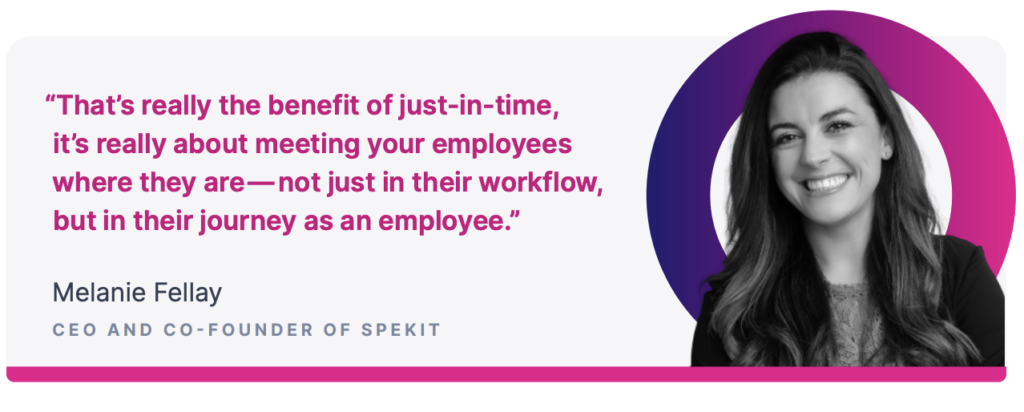
Being able to provide that kind of optimization tool yields benefits across the board and creates a consistent expectation that, because information will be where they need it when they need it, they can more easily slip into a flow state at work. Creating more space for your team members to experience intense focus and immersion in their most pressing projects will also increase satisfaction at work. And that leads to creative problem-solving that the fragmented mind wouldn’t be able to achieve.
The shift from onboarding to everboarding just makes sense
Have you ever started a new job and learned everything you need to know in the first week? Of course not, and no one would ever expect that. Since we’ve established that learning at work — especially in today’s fast-paced market — is an ongoing process, the shift from onboarding to everboarding is a natural evolution. And it, along with a solid change management strategy, keeps businesses on the cutting edge.
What is everboarding? It’s a more holistic approach to learning at work that recognizes training as an ongoing process rather than a “one-and-done” occasion. While constant learning might sound exhausting, this model opens the door to making learning a habit and routine that empowers and empowers employees with the support they need. As opposed to inundating or oversaturating them with information they don’t immediately need.
“It’s really about recognizing the fact that there's a certain amount of information that's going to be really valuable in getting someone confident, comfortable, and energized about their role,” says Spekit’s Melanie. “But the reality is that most of your learning will happen as you come across all these different scenarios.”
Enabling that constant state of learning through everboarding is a direct reaction to a growing need for change management. The world is in a constant state of change, and with the rise of new technology and shifting economic conditions that means businesses need to adapt faster than ever. A supportive change management structure means leaders need to provide their employees with the tools and resources they need to stay on top of all the education this constant change requires. Companies are sensing that shift and moving to more flexible, agile, training that can quickly adapt to the changing business landscape.
“It can no longer be, ‘hey, let's have everyone go through all these courses in the first 30 days like a boot camp, and then it’s trial by fire,” says Melanie. “What if it looked more like ongoing support?”
Learning by doing with just-in-time
To make the leap from absorbing information to becoming knowledgeable, there needs to be a certain amount of participation from the learner. When Nick Lawrence designs curricula for enablement teams, he keeps that in mind.
“People have to be, and have to want to be, active participants in their learning. Learning rarely happens from the outside in, where information is being pushed at someone,” he says.
“Oftentimes, true learning comes from being an active participant, figuring it out yourself. It always comes from the actual application — from doing it.”
Of course, anyone who’s ever read instructions and given something new a shot knows you don’t always get it on the first try. “Then it’s about being constantly exposed to it and learning to retrieve that knowledge from memory when you need it,” says Nick. It’s common to require a reference point even the fourth or fifth time you try something — that’s all part of building up a pattern of doing and recalling that transitions the action into knowledge. Having a tool that can guide you in that process, rather than a human manager or colleague, takes the pressure off both the knowledge-seeker and their trainer.
Consistent access to information is the best way to empower employees, and just-in-time learning gives employees the confidence to reference a guide or cheat sheet as often as they need until it becomes natural to them. Then it will be onto the next new operation or platform, and the cycle of learning by doing begins again — but this time, it’s a positive habit. Remember: learning isn’t a destination, it’s a process that needs to be treated sustainably.
Reinforcement and the forgetting curve
Maybe you’ve heard of the forgetting curve: it’s a theory that says without reinforcement, the average person will forget anywhere between half and up to 90% of what they learn in less than three weeks. That’s because so much of what we absorb we do so temporarily. But studies have shown that if you review the information you’ve learned for 10 minutes within the first 24 hours of learning, your retention will be almost 100%. As days go on, you’ll require less and less time to get back up to speed (only two to four minutes of review at the 30-day mark) because you’re creating a pattern of reinforcement in your brain.
“This is why everboarding is absolutely crucial,” says Sheevaun Thatcher. “We have goldfish memories. You have to have the ability to trickle training out and reinforce it. When you don’t have reinforcement, that’s when people fall back to old ways.”
Science bears out, but the solutions don’t meet people where they are. Rather than reinforce with ongoing half-day training sessions or weekly mandatory webinars, why not put that reinforcement directly into the flow of work?
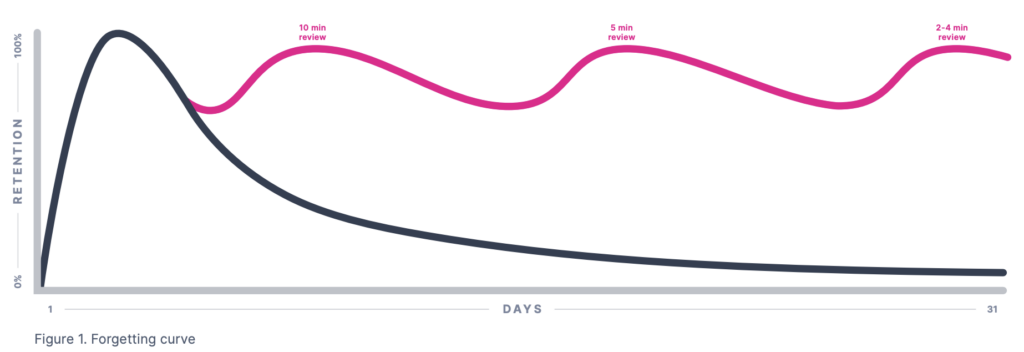
“When people are seeking the information they need and can’t find it, they start to flounder,” says Kari Roberts. “And when people flounder, if they can’t get access to the process, they make up their own.”
Everboarding using just-in-time learning is a scalable way to keep learning at the forefront of employees’ minds so that seeking answers doesn’t become an entire task on its own that derails a day’s work. By providing the information you know your people need right where they’re already working you can ensure the processes you’ve strategically put in place will be followed to the letter. And that your teams will feel empowered and confident in their daily roles. This will, in turn, increase productivity and performance and accelerate revenue generation.
Embracing the future with just-in-time learning
The challenges businesses have faced in recent history have resulted in a lot of growing pains — but growth is happening, and it’s making workplaces better as a result. As employees learn their worth and demand more from organizations, company leaders must meet those challenges with the kind of support that will earn loyalty.
Spekit is one of the tools that can get you there. The number one-ranked just-in-time learning platform is founded on principles that directly address current business challenges.
By surfacing learning in the tools your team uses every day, it closes the gap between learning and doing. Spekit helps companies boost productivity, improve the adoption of key business investments like Salesforce, drive change across remote organizations, and makes training easy and accessible. Spekit’s just-in-time learning platform delivers bite-sized knowledge when and where your employees need it so they can excel at their jobs and build real business outcomes.
“Training is a strategic lever inside an organization to actually help make a difference,” says Sheevaun. “It helps us change the status quo.” In a time of shifting business needs, one big shakeup can lead to many positive outcomes, from revenue growth, to simplicity of scaling, to employee retention.
Imagine how your team could look if the gap between having questions and getting answers was eliminated. How much time could you save? How would your day shift?
Learn more about Spekit and how you can implement just-in-time learning today. Request a demo!







